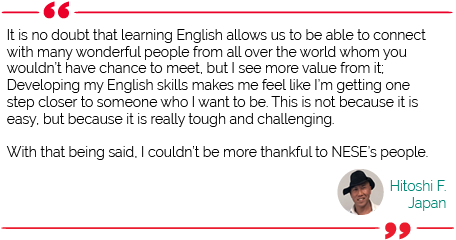Punctuation Essentials
Save Your Grandmother!
On the previous page, we gave you an example of the incorrect use of punctuation:
Let’s eat grandmother!
Let’s eat, grandmother!
The only difference between these two sentences is just one little comma, but what a big difference this one little comma makes to the meaning! Using punctuation is like writing a piece of music. The placement of crescendos and rest notations are critical to the music - critical to what the audience experiences. Punctuation is no different - and it could save your grandmother’s life!
- 50 Minutes per Day - 1 Day per week - 2 Weeks
- Minimum Level 6 Required to Take Course
- Learn Obvious and Subtle Punctuation Rules
- Develop Skills Necessary across Writing Environments: Academic, Professional, and on Social Media
- All NESE On-Line Teachers are Native Speakers (Always)
- 30 Years of NESE Curriculum Research & Development Provide Foundation for Course
The Importance of Punctuation:
There is obviously a difference between “A bear eats shoots and leaves.” and “A bear eats, shoots, and leaves.”
There is also a difference between “I like to watch the sunset”.
or “I like to watch the sunset.” Both are correct, but obviously, to express yourself correctly in English, you need to know which one to use.
Finally, there is an obvious mistake here: "I love to eat spanish
food." Can you spot the mistake?*
The correct use of punctuation marks is an essential tool in writing well in English, as essential as good vocabulary, good grammar, and good spelling. Without it, your writing can just seem like a list of words. Thus, knowing the basic rules of punctuation is fundamental, not only to being able to write well in English, but also to convey what you really want to say in a clear and concise way. We all want to be understood, and not misunderstood (especially when talking about our grandmothers)! The NESE On-Line Punctuation Course is a key step in ensuring that your written English is both easily understood and effective.
*In English, the names
of countries, and the adjectives derived from their names, are always capitalized. (Look how many commas were used here!)
What You Will Learn:
Regardless of the environment in which you must write in English, key rules apply. In this course, you will learn not only the obvious rules of punctuation, such as the use of capital letters, periods ("full stops" in Commonwealth countries), and quotation marks, but also the use of more subtle punctuation marks such as colons, semi-colons, ellipses, hyphens, dashes, apostrophes and quotation marks.
You will be taught essential techniques so that you can make your writing say exactly what you want it to say - clearly and concisely - or not, if you prefer. Your teacher will also highlight the differences in punctuation that is used in professional and academic writing as well as that used in more informal situations such as on social media.
Never be afraid to make a mistake. Your teacher is here to help you. If you try and are correct, that is to your credit. If you try and you make a mistake, that is an ideal opportunity for your teacher to help you, and for you (and the class) to learn something new. Trying is important; perfection 100% of the time is not. Remember, “Mistakes are not important; Understanding is”TM
